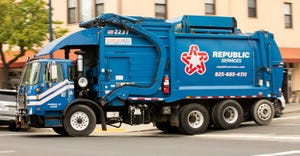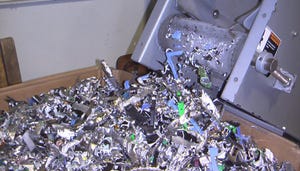Small Private Hauler Earns Big City Role
April 1, 1995
Susan DeGrane
As you take to the streets of Chi-cago, try viewing it through the eyes of a local hauler. Chicago haulers must overcome difficult challenges, in-cluding heavy traffic, in-clement weather and narrow streets.
With 80 trucks and 155 employees, Chi-cago-based National Waste Services rises to the occasion six days and nights a week. "This is a complex city to re-move the waste from," said Rick Wojahn, sales manager for the company that services 9,000 commercial customers in Chicago and its im-mediate area.
"During the winter, we have to plow the snow to get into some places. Some downtown buildings were built during horse and buggy days. Some alleys are so tight that our drivers have to fold the truck mirrors or roll trash containers 200 feet because the truck cannot make it into the space. Our drivers have a tough job."
Beginning at 4 a.m., the day crew must compete with delivery trucks and other day traffic. The pickup points which are nearly impossible to access during the day are left for the night crew.
From 4 p.m. to 3 a.m., the night crew brings garbage and waste through circuitous journeys up elevator shafts, past revolving doors that are folded flat and out to the curbs of Chicago's showier streets, Michigan Avenue and LaSalle Street - where all traces of trash must disappear before dawn to avoid soiling the image of the Windy City.
The company's night crew handles some of the toughest jobs, said Wo-jahn. "They seem to have a special bond between them. For example, the night maintenance crew had T-shirts printed that read 'Relax, the night crew is here.' Many of National's drivers and mechanics begin on the night crew and eventually move to a daytime po-sition."
"Seven night drivers work while the rest of us are sleeping," said Dis-trict Manager Don Slag-er. Most of the people don't realize what the waste industry has to accomplish at the start of each day, said Slager, who in his mid-thirties has worked in and a-round the waste industry since his teens. "I think they would be a-mazed to see the amount of effort it takes to keep the city clean, especially between the hours of 6 p.m. and 6 a.m." From salespeople to dispatchers, office support personnel to transfer station workers, Slager credits all of the company's employees for getting the job done.
Growing Up In 1972, National Waste Services, which was based in South Holland, Ill., used one truck to operate its waste collection service. "At one time, there were more than 200 waste haulers in the Chicago area," said Slager, who has been with the company since 1985. "However, the increased regulations in our industry have prompted many haulers to join forces with larger companies. Today, there are approximately 40 waste haulers in the Chicago area."
"We've tripled in size over the last three years," Slager said. National sought companies with a strong customer base and quality service, he said. As a result, National has ac-quired 16 companies including Ac-me, Ajax, B&W, Crosstown, Duke, Emmet, Peter Laning & Sons, Post, Sanitary, South Suburban, Superi-or, Southwest and West Englewood. While some of the acquisitions en-abled National to service new territories in most cases it gained customers in areas it already serviced, Slager said.
"We were already going down the same alleys they were going down. But after the acquisitions, we eliminated the crossover of their routes. This enabled us to do the same a-mount of work with less equipment," said Slager.
According to one of National's ma-jor accounts, the acquisitions in-creased the company's level of efficiency. "We had been using their services for 14 or 15 years," said Joe Scott, facility services manager for a Chicago retailer that occupies 3 million square feet of space. "Now they have a service manager and two ex-perienced dispatchers," Scott said.
"They brought in their new dispatchers to see our operation. They wanted these guys to know that when we call to order a container, we need one right away. We may fill four to five 30- to 35-cubic-yard containers in one day with broken pallets and wood debris. For garbage, we use a 42-yard compactor."
The company's customer base primarily consists of commercial customers who generate significant quantities of corrugated board, office paper and newsprint. By volume, it's the largest quantity of post-consumer material that the company processes, according to company Re-cycling Coordinator Andrew Leigh-ton. The company has recycled these materials since 1988.
With the coming of the blue bag recycling program, National will ex-pand the number of recyclables it re-ceives, processes and sells to buyers. Until recently, the firm has dealt primarily with recycled paper materials. Every day, a continuous stream of trucks owned by surrounding paper brokers makes its way to National Waste Services' transfer station/ materials recovery facility (MRF) to cart off the post-consumer paper.
In 1992, Allied Waste Industries of Scottsdale, Ariz., purchased National Waste Services. As a result, the company's former owner, Rich Van Hat-tem, became a vice president of Al-lied Waste. He now works out of Al- lied's regional office in Homewood, Ill., and concentrates on acquisitions and development in several states.
By joining a larger company, Na-tional gained access to added capital which gave the company the necessary strength to expand in the Chi-cago area. The new membership also gave National access to Allied's five landfills within trucking distance of Chicago.
"From a marketability standpoint, it's better to move our waste to our landfills," Slager said. "People today want to know that their wastes are being handled responsibly. Now, with the assistance of Allied's management team, we can offer long-term disposal agreements to our customers."
National has increased the number of big accounts they service, Slager said. "They ask, 'What landfills do you use?' and they request site visitations of our facilities."
As for many waste companies, landfill regulations brought changes for National. "In the beginning we would drive into the city, load our trucks and then drive to the landfills just outside the city limits," Slager said. "In 1985, when landfills began to close, we built a transfer station so that we could transport our waste longer distances." Also in 1985, Na-tional Waste Services purchased a building and moved its suburban South Holland office to the company's current headquarters, dispatch station and maintenance facility.
Focus On Recycling Chicago's Recycling Initiative is a plan to reduce the city's waste by 37 percent, or more than 1 million tons per year. To receive a business permit in Chicago, all local businesses must prove that they have an effective recycling program supported by their private scavenger service.
"Our job is to offer a recycling program that fits the city's guidelines," said Leighton. "The majority of our customers are smaller businesses. We do everything from a one yard pick up every two weeks to servicing accounts with 30- to 40- cubic-yard containers daily or several times daily." National's commercial ac-counts include industrial facilities, apartments, retail establishments, schools and restaurants and bars.
The various ethnic backgrounds of Chicago's residents presented another challenge. For some, the educational materials explaining the city's new recycling program had to be translated. For example, recycling posters were printed in English, Spanish and Polish to educate businesses who would be separating their recyclables.
National, as well as other waste haulers, gave its input on the final draft of the Chicago Recycling I-nitiative.
"In Chicago, we're one of the top five haulers in size," Slager said. "We try to meet our customers needs ahead of time. For instance, we educated our residents about the city's recycling program before it became mandatory." According to Leighton, the local businesses seemed anxious to participate in the recycling program and to do their part to deal with the waste.
Since 1988, National's transfer station has expanded to include corrugated cardboard and paper recycling, but with the blue bag program, the facility has taken on a new role and identity. It also functions as a MRF. Quite appropriately, it has been dubbed Planet Recovery Sys-tems. At this facility, blue bags and other recyclables are taken out of the waste stream.
National Waste operates a third fa-cility in Chicago, called Planet Re-sources. At this location, the clean recyclables from the blue bag program will be sorted, baled and compacted for distribution to brokers.
National Waste chose the blue bag program for several reasons, including the fact that it's adaptable to any size business or establishment. "We offer other services for customers that generate large volumes of recyclables. These services include designated balers and compactors and separate pickups," Wojahn said.
National customers must purchase the bags from retail stores and janitorial suppliers. They also can call National to place bag orders. The blue bags are a tough grade of clear blue plastic. Small ventilation holes, Leighton explains, allow air to e-scape so that the bags don't burst while compacting.
"There is some contamination," Wojahn said. "But the participation is so much higher because the program is simpler and less costly for the customer. Also, it can easily be expanded - we expect to get the li-on's share of recyclable material. People are able to recycle as many as six or seven different items."
National also collects and recycles construction and demolition (C&D) wastes. The company's involvement with this segment of the waste in-dustry has led to a new service: supplying portable toilets at construction sites, in tandem with C&D roll-off containers. National also supplies portable toilets for summer festivals and outdoors events.
National is proud of its employees and its history. The company has an office wall which bears historical photographs of trucks and buildings belonging to National's acquisitions.
"We want the people that come from these companies to know that their history is part of what makes us strong," Slager said. "We want them to know we appreciate where they came from and the contributions they make."
You May Also Like


